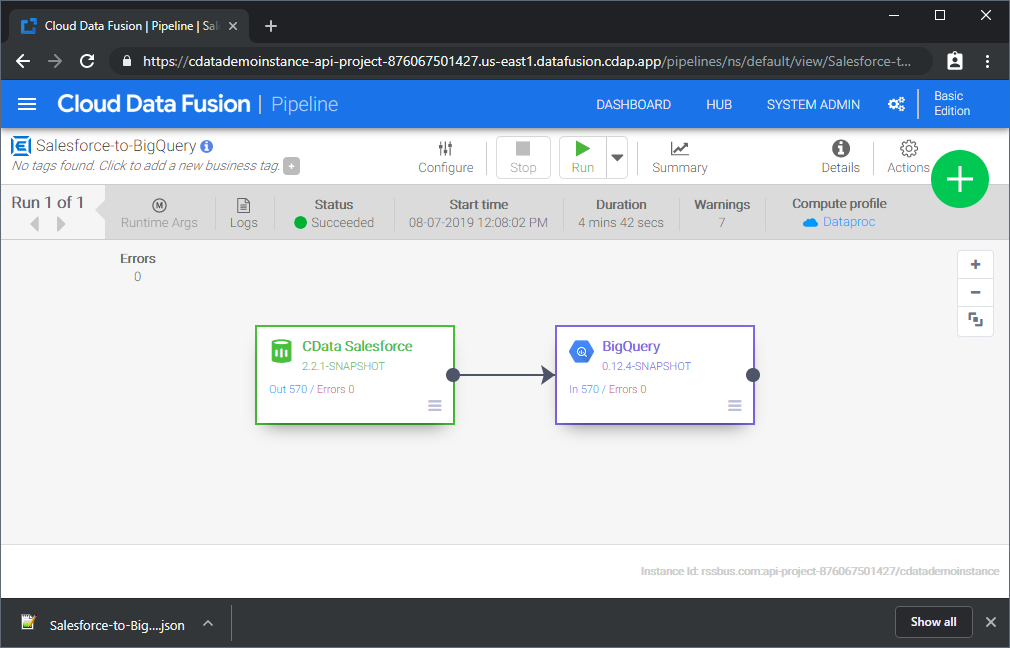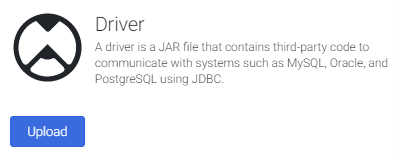Discover how a bimodal integration strategy can address the major data management challenges facing your organization today.
Get the Report →Build HCL Domino-Connected ETL Processes in Google Data Fusion
Load the CData JDBC Driver into Google Data Fusion and create ETL processes with access live HCL Domino data.
Google Data Fusion allows users to perform self-service data integration to consolidate disparate data. Uploading the CData JDBC Driver for HCL Domino enables users to access live HCL Domino data from within their Google Data Fusion pipelines. While the CData JDBC Driver enables piping HCL Domino data to any data source natively supported in Google Data Fusion, this article walks through piping data from HCL Domino to Google BigQuery,
Upload the CData JDBC Driver for HCL Domino to Google Data Fusion
Upload the CData JDBC Driver for HCL Domino to your Google Data Fusion instance to work with live HCL Domino data. Due to the naming restrictions for JDBC drivers in Google Data Fusion, create a copy or rename the JAR file to match the following format driver-version.jar. For example: cdatadomino-2020.jar
- Open your Google Data Fusion instance
- Click the to add an entity and upload a driver
![]()
- On the "Upload driver" tab, drag or browse to the renamed JAR file.
- On the "Driver configuration" tab:
- Name: Create a name for the driver (cdata.jdbc.domino) and make note of the name
- Class name: Set the JDBC class name: (cdata.jdbc.domino.DominoDriver)
![Configuring the driver (Salesforce is shown.)]()
- Click "Finish"
Connect to HCL Domino Data in Google Data Fusion
With the JDBC Driver uploaded, you are ready to work with live HCL Domino data in Google Data Fusion Pipelines.
- Navigate to the Pipeline Studio to create a new Pipeline
- From the "Source" options, click "Database" to add a source for the JDBC Driver
![Adding a database source]()
- Click "Properties" on the Database source to edit the properties
NOTE: To use the JDBC Driver in Google Data Fusion, you will need a license (full or trial) and a Runtime Key (RTK). For more information on obtaining this license (or a trial), contact our sales team.
- Set the Label
- Set Reference Name to a value for any future references (i.e.: cdata-domino)
- Set Plugin Type to "jdbc"
- Set Connection String to the JDBC URL for HCL Domino. For example:
jdbc:domino:RTK=5246...;Server=https://domino.corp.com;Database=names.nsf;Port=3002;SSLClientCertType=PEMKEY_FILE;SSLClientCert=full_path_of_certificate.pem;SSLServerCert=*Prerequisites
The connector requires the Proton component to be installed. Normally, Proton is distributed as part of the AppDev pack. See the HCL documentation for instructions on acquiring and installing Proton or the AppDev pack.
Once the Proton service is installed and running, you will also need to create a user account and download its Internet certificate. This certificate can be used to set the connector certificate connection properties.
Authenticating to Domino
- Server: The name or IP address of the server running Domino with the Proton service.
- Port: The port number that the Proton service is listening on.
- Database: The name of the database file, including the .nsf extension.
- SSLClientCertType: This must match the format of the certificate file. Typically this will be either PEMKEY_FILE for .pem certificates or PFXFILE for .pfx certificates.
- SSLClientCert: The path to the certificate file.
- SSLServerCert: This can be set to (*) if you trust the server. This is usually the case, but if you want to perform SSL validation, you may provide a certificate or thumbprint instead. See the documentation for SSLServerCert for details.
Additional Server Configuration
The connector supports querying Domino views if any are defined. Before views can be queried by the connector they must be registered with the design catalog.
Please refer to the Catalog Administration section of the AppDev pack documentation for details on how to do this.
Built-in Connection String Designer
For assistance in constructing the JDBC URL, use the connection string designer built into the HCL Domino JDBC Driver. Either double-click the JAR file or execute the jar file from the command-line.
java -jar cdata.jdbc.domino.jarFill in the connection properties and copy the connection string to the clipboard.
![Using the built-in connection string designer to generate a JDBC URL (Salesforce is shown.)]()
- Set Import Query to a SQL query that will extract the data you want from HCL Domino, i.e.:
SELECT * FROM ByName
![Configuring the database source]()
- From the "Sink" tab, click to add a destination sink (we use Google BigQuery in this example)
- Click "Properties" on the BigQuery sink to edit the properties
- Set the Label
- Set Reference Name to a value like domino-bigquery
- Set Project ID to a specific Google BigQuery Project ID (or leave as the default, "auto-detect")
- Set Dataset to a specific Google BigQuery dataset
- Set Table to the name of the table you wish to insert HCL Domino data into
![Configuring the BigQuery sink]()
With the Source and Sink configured, you are ready to pipe HCL Domino data into Google BigQuery. Save and deploy the pipeline. When you run the pipeline, Google Data Fusion will request live data from HCL Domino and import it into Google BigQuery.

While this is a simple pipeline, you can create more complex HCL Domino pipelines with transforms, analytics, conditions, and more. Download a free, 30-day trial of the CData JDBC Driver for HCL Domino and start working with your live HCL Domino data in Google Data Fusion today.












